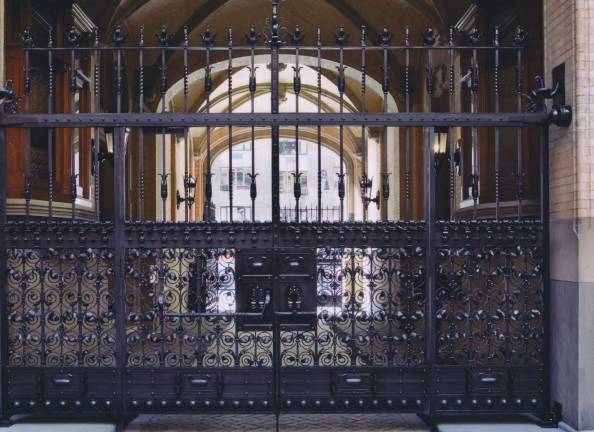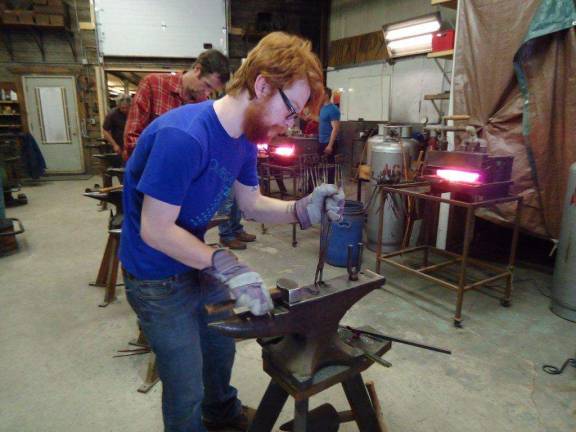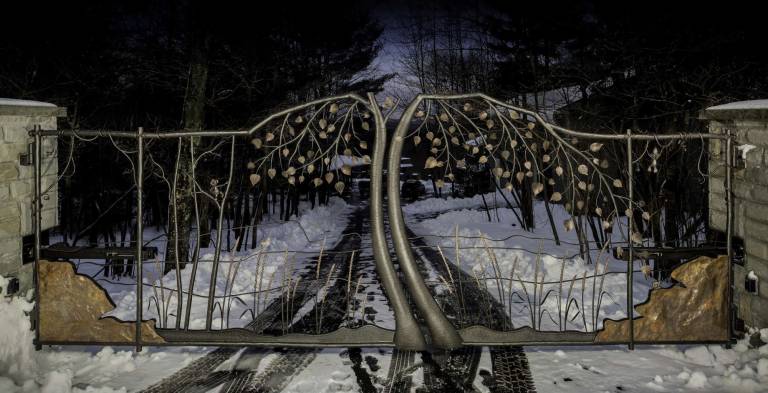The incognito blacksmith



You will find nary a horseshoe at the Center for Metal Arts. Horseshoes, as they say here, are for farriers.
The smiths of the Center for Metal Arts make work that is so fine, imaginative and surprising that it can only be rightly classified as art. Which is not to say that there’s no place for the practical here. Candelabra, iron gates and wrought metal railings are testament to that. But it is safe to say that everything that comes out of the Center for Metal Arts tends toward the creative.
Take for instance the recent commission of a fanciful 20-foot wide woodland themed iron and copper gate for a private residence in the valley of the Ashokan Reservoir; or the Renaissance-style interior gate of the Manhattan’s landmark Dakota building.
The Center for Metal Arts has been around for decades, but chances are you’ve never heard of it. It’s one of the best kept secrets of the local consciousness, but it is certainly well known among those in the field.
Hidden in the wide open, the Center for Metal Arts is a block off the main drag in Florida, New York in an impressively historic and now refurbished former Borden’s Creamery icehouse, which dates back to 1890. With its look of an oversized barn, the old icehouse is now home to a commercial fabrication center (Fine Architectural Metalsmiths) and a school for the metal arts. On a second floor, which still bears the marks of 18 levels of ice storage, is an expansive showroom and office.
The center’s story goes back decades, to when newly married and recently minted college students Ed and Rhoda Mack pondered their futures with more than a little apprehension. He had a degree in anthropology; she had majored in English. How to pay the bills, make a living, build a life? Unafraid of a little more education, Ed enrolled in every course BOCES had to offer. The course in blacksmithing spoke to him.
“There was the fascination of working with fire,” says Ed, ever the anthropologist.
What is now the Center for Metal Arts and Fine Architectural Metalsmiths began in a plain cinderblock building near the Mack home in Monroe. From there it moved two more times until the Florida-based lumber company Roe Brothers mentioned the building next door. Back then the icehouse was truly invisible, having been nearly swallowed by a veil of ivy vines. In 2003, the forges and classes of the Metal Arts, with the help of revolutionary Israeli metal artist Uri Hofi, gave the icehouse a new life. Hofi, who invented the ergonomically designed Hofi hammer that saves blacksmiths’ backs and necks, has drawn students from as far as Africa. Classes taught by master metalsmith Charles Lewton-Brain have grown into an annual competition that tests talents in the heated metal folding technique that Lewton-Brain developed.
While neighbors who drive past it every day have no idea what’s going on in the old icehouse, these innovations have led to widespread industry recognition for the center. In 2012, Ed Mack won the prestigious Julius Bloom Award, given to an organization or person who makes an outstanding contribution to the metal arts and fabrication industry.
Today the Center for Metal Arts is a busy place. Even on a cold day in January, visitors took in the hundreds of twists and shapes of metal, the sconces, sculptures and inlaid tables that populate the show room. Downstairs the forges were glowing and the smiths – both men and women – worked hammer and tongs to bend iron to their will. The scene, at once modern and ancient, affirmed the truth of what Rhoda Mack says: “From the blacksmith, all things come.”